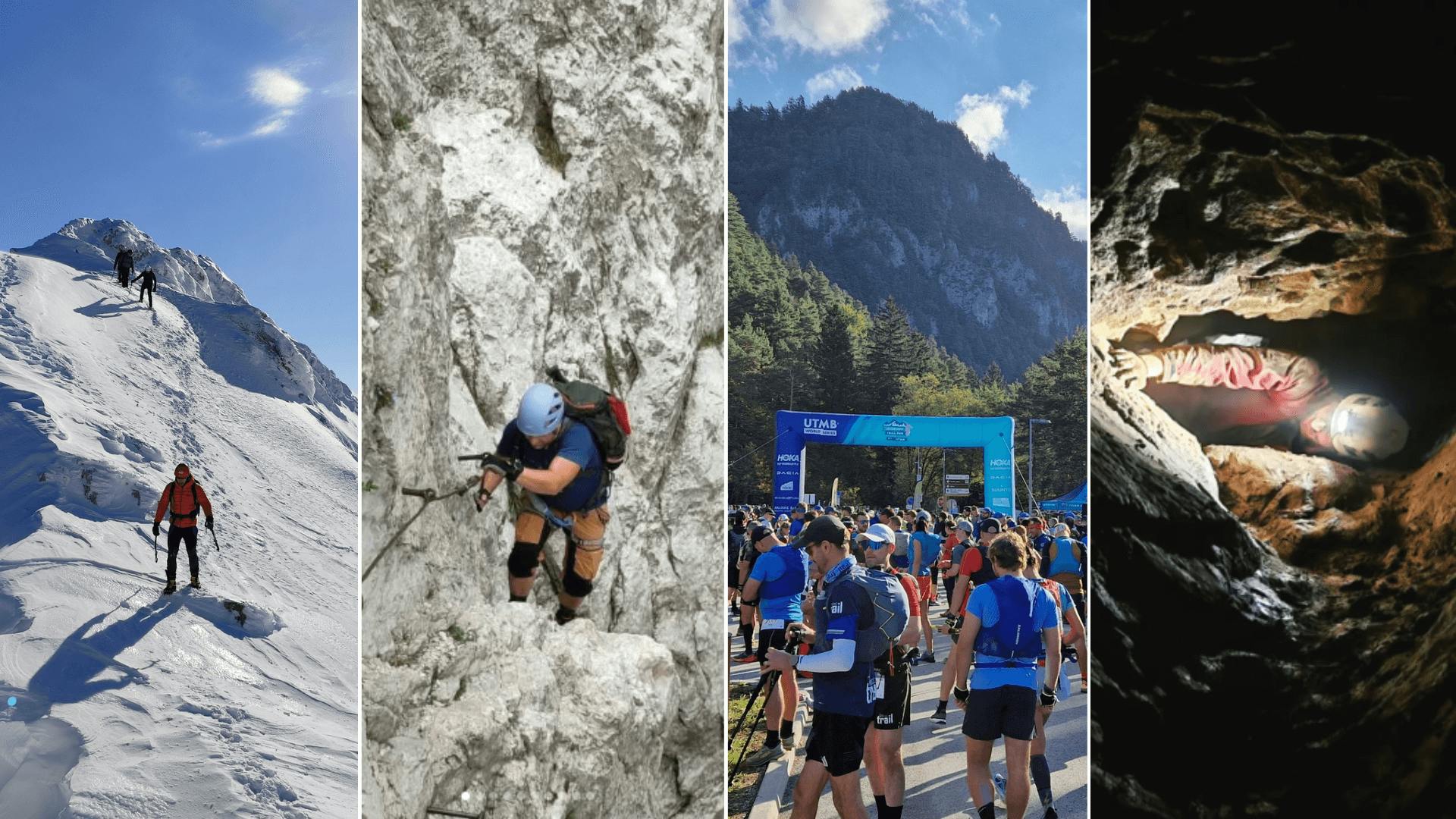24 April 2025
The adventures of Davor Pavleković: From climbing to caving, ultramarathons and coding

From mountain and glacier climbing to caving, ultramarathons, expedition racing and mountain biking, the life of our senior developer Davor Pavleković is nothing short of adventure. He climbed 26 Central European mountain peaks in a single year. He ran a 55-kilometer ultramarathon in the Alps and has just finished a 70-km race in Istria. He dropped out of college, went to the army (and flipped the truck in the wood), taught himself coding, and ran his own company.
So when we started the interview, and he said he didn’t like talking, I got worried. In a split second, I imagined a small camera hovering above him 24/7, to get a full sense of everything he did, and how he did it. Yet, his story found its way out, and putting it in writing was overwhelming.
Once he vacationed on the island of Murter in the Croatian south when he learned about the remains of an old military complex on Raduč hill. He got up at 6:30, grabbed his flashlight and went exploring. His wife and daughter were just up when he got back. Years ago he co-founded a news portal covering mountain climbing and remains a key contributor. He teaches kids about hiking and outdoors, and helps in the speleology school. He is a licensed mountain guide. He captured natural beauties across Europe in thousands of photos. Recently he started blogging on Medium.
Admittedly, he doesn’t sleep much.

Working with Nikola early on
Davor’s experience in software development and IT spans more than 20 years. He has been with Emil Frey Digital from day one, for over 7 years. Before that, his company cooperated with the early-day venture that Nikola Novaković had started with his team.
- Nikola and I had business ties, and we had an understanding that, if his company was acquired, we would all move to the new company, he said.
After highschool, Davor started studying at the Faculty of Transport and Traffic Sciences. Soon he realized it wasn’t his cup of tea. Then he was called up for military service, which changed the course of his life. He never returned to the university. - I got interested in how to build a website. I started digging and building on it. I did finish some courses, but I learned coding mostly on my own, and from my mistakes, he revealed.
When the global financial crisis hit, the company he worked for ran out of money and stopped paying salaries.
- In situations like that, you inevitably look at your options. I could get a job at another company, but I decided to start my own thing. That year we became parents. I learned a major life lesson: always have plan B. No matter how wonderful a time you might be having at some point in your life, you must plan for tough times, he said.
As an entrepreneur, he went through the usual ordeal: stressful beginnings and risk, employing several people, working weekends and nights, clients that didn’t pay. It was taking a toll on his family, too. He couldn’t leave his laptop behind or have a proper vacation. Still, he says it all paid off when they joined the Emil Frey Group. On top of doing major dev stuff, he is mentoring younger developers.
- It’s not about telling them how to do things; it’s more about providing direction and supporting them in finding their own path. I like it best when they are very ambitious. I let them learn from their mistakes. A lot of them have improved that way, he revealed.
Where’s the appeal in such demanding, exhausting and dangerous hobbies of his, I ask.
- You tire yourself out, but in fact you get rested. It’s a perfect reset button. I’ve been hiking since I was a kid, and I’ve taken it to another level in the last ten or fifteen years. My entrepreneurial days were stressful, I needed something to help me wind down. Also, I am temperamental. Activities like these make me calmer, he revealed.

Living right by the mountain - and using the advantage to the fullest
Conveniently, Ivanšćica mountain is next to his house. He can get out the door and reach the top in a little over 30 minutes. And he is using the advantage to the fullest. You will rarely see two or three days pass by without him climbing, running, cycling or training there.
He admits that his lifestyle requires a lot of planning, and a supportive family. His every weekend is about activity and going somewhere: either with his family or with mountaineers or speleologists. It can be training in Ivanšćica, a shorter climb nearby, or a two-day trip to Slovenia. Once per month he goes on a more strenuous trip. That has become his standard.
Two years ago the family went to Matterhorn in Switzerland. Last year in Poland, they combined hiking in the Tatras and visiting places in Poland. They got to know Switzerland, Italy, Austria, Slovenia and other countries on road trips. Slovenia is a favorite: so close, with so much beauty.

When on excursions with hikers, they will often combine several sports. Last year in Paklenica, they combined climbing and caving. In Austria’s Grossglockner, they did glacier traverse and climbing.
Fear and discomfort are an integral part of such a lifestyle. Sometimes you will get claustrophobic, too. He learned the importance of staying calm.
- When descending into a cave, in some places you wait for someone and you secure the rope for them. As you move deeper underground, you start thinking about where you are and what could happen. Once I got stuck in a narrow passage, a colleague had to pull me out. There is no room for panic, but there is room for fear. With climbing, there is the fear of falling. But it does weaken over time, so I would say my feelings now is closer to caution.
He tells about the deepest cave in the region of Zagorje, which speleologists are monitoring. It isn’t laid out vertically, and it is so narrow that you can’t move your hands as you go down the rope. - When you go in for the first time, you don't know what awaits there. The second time, you don't feel like going in. But something pushes you to go again, he explained.

Dinara as one of the favourites
He doesn't know the number of peaks he has conquered, but one year he climbed 26 of them! Many are in Croatia, Italy, Austria and Slovenia, his hiking bases. He climbed Dinara three or four times. The most beautiful and the hardest climb there was over via ferrata, which is a protected climbing route with steel fixtures. He says he would do it again.
Right now, he is not attracted to trekking peaks that are too easily accessible. He says he is leaving those for when he retires. The Alps, which are more demanding, are more appealing. Davor would like to get to the highest peak of the Alps - Mont Blanc (4806 m) and the highest peak of South America, Aconcagua (6962 m).
- Mont Blanc is fairly close, it will happen sooner or later. Going to Aconcagua is more of a challenge. I am more into South America than Himalaya, but that’s a three-week trip that’s not so easy to pull off, with work, family and everything else going on. Such a big trip is one big game of chance. If you happen to get there at the wrong time, you will not have the time of your life, but one big disappointment.
Running back to the glacier: Mountain is stronger
Davor says that every climb is memorable in some way. Either the group was great, or the route was hard, or there was a great party afterwards. - The peak is not so important, but the journey to the peak. I am looking for a challenge, how to get to it.

Grossglockner in Austria was a dangerous race against time.
- We knew that bad weather was coming. On top of that, we took the wrong route and lost half an hour getting back on track. When we reached the top, we could see the storm up close. We literally ran down, back to the glacier.
Some of the most beautiful climbs start in Logarska Dolina. They are steep, demanding. Davor likes to go there several times a year. He already went to all the peaks there - and experienced one of the most dangerous situations so far.
- It was the beginning of winter, the fog had lifted, the freezing rain had started. We were caught in a storm and had to turn back. We didn't hear the rocks falling nearby because of the wind and rain. In situations like these, you have to stay calm and simply turn back. The mountain is stronger, you admit defeat and retreat. The worst thing you can do is push on. It’s surprising how many people don’t realize that, he said.
Trail races: Aiming for 100 km

Last year he ran 55 km in the Alps. Recently he finished a 70-km race in Istria, his longest so far. He would like to run 100 km.
- I know I'm not ready for it, but I'll try. Maybe I can do it. It’s a competition with yourself. In long races, you go through several ups and downs. You have to keep yourself going. That mental aspect is important in other things in life, too. Think about work, when you are up against something difficult. You want to give up or pass the problem to someone else. It takes effort to keep working on it.
The lifestyle of adventure and physical exertion takes a toll on the body, and sometimes you must overcome serious pain, too, which is another test of endurance. Last year in the Julian Alps trail he hurt his ankle, but he still finished the race.
- Before that, I had already sprained it several times so I had no stabilization. On top of that, my knee started hurting. The ligaments no longer held up properly and I got muscle fatigue. I had to walk sideways and even backwards, using poles! The last 5 km were the hardest, he said.

Cooperate. Don’t postpone your decisions.
There are other important lessons to be learned that can serve you well in life and work.
- When you explore caves, you need a lot of people and equipment. And these 20 or 30 people won't all come down and explore, but they will participate in carrying equipment, setting ropes, and some of them will go down. It’s important that everyone cooperates, so that 5 people can reach the cave bottom. The group has a common goal.
- Decision-making is another interesting thing. In some situations you have to make a decision quickly. It's usually not the best decision, but it keeps you alive - at that moment it's a good decision, he concluded.

